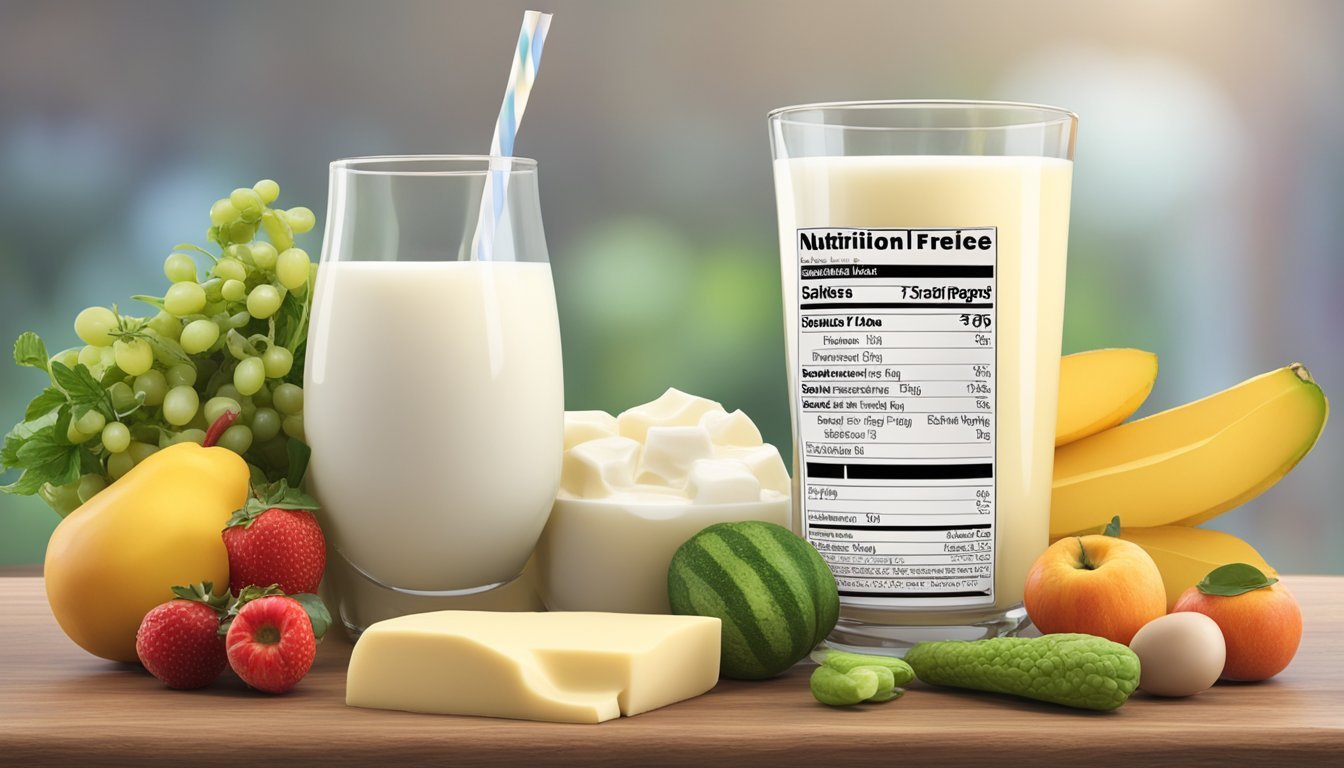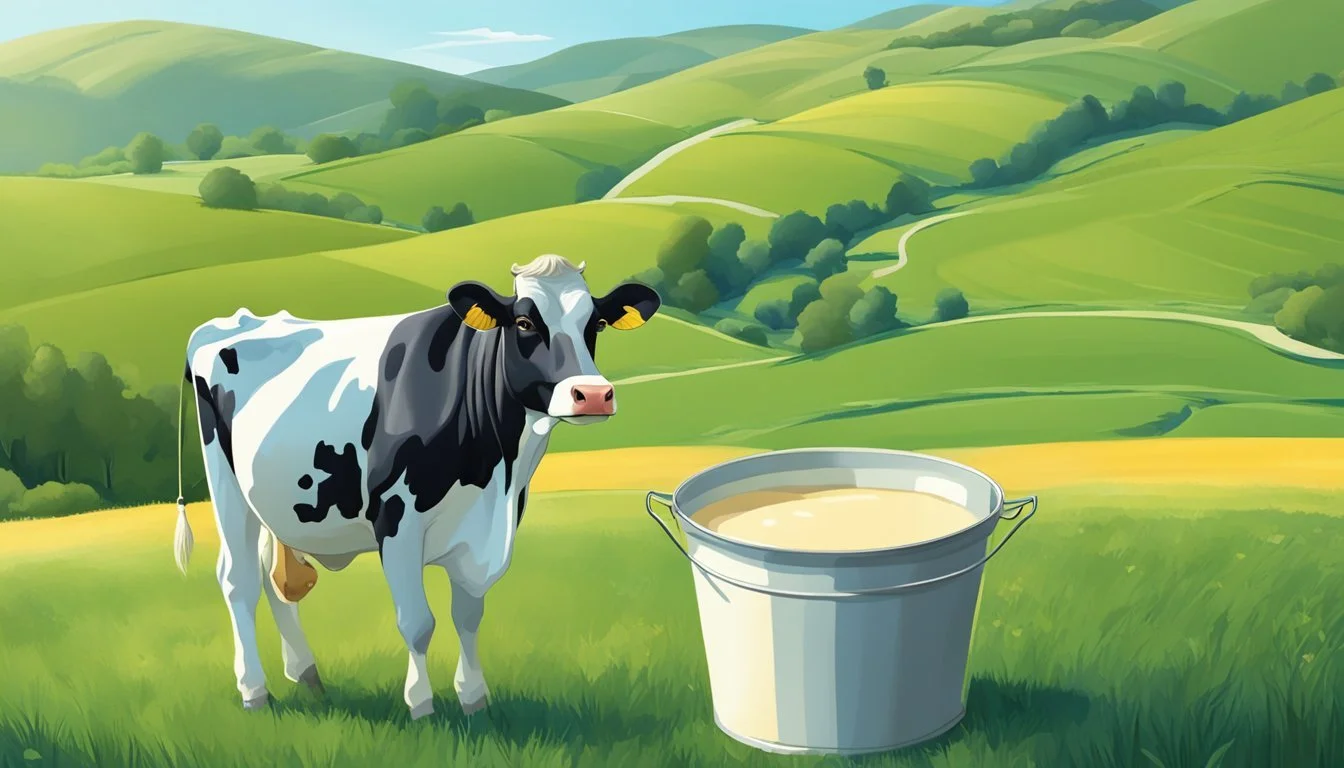The Nutritional Profile of Raw Milk
Exploring Its Natural Benefits and Risks
Raw milk, often touted for its rich nutrient profile, stands in contrast to its pasteurized counterpart available in most grocery stores. This unprocessed milk comes directly from the animal, usually cows, sheep, or goats, without undergoing the heat treatment known as pasteurization, which is designed to kill harmful bacteria. Proponents of raw milk consumption highlight its content of natural enzymes, probiotics, and higher levels of fat-soluble vitamins like A, D, E, and K. Also, it contains water-soluble vitamins such as B12 and B6, and key minerals including calcium, phosphorus, magnesium, and iron. The presence of omega-3 fatty acids and conjugated linoleic acid has also been reported, nutrients that have been associated with various health benefits.
Critics of raw milk, however, point to the potential food safety risks associated with its consumption. The pasteurization process that raw milk forgoes is specifically intended to reduce the risk of foodborne illnesses that can be carried in milk, such as those caused by E. coli, listeria, and salmonella. Consequently, while it is true that pasteurization can affect the nutritional and sensory qualities of milk, it is equally true that it considerably lowers the risk of transmitting diseases.
The nutritional elements of raw milk contribute to its appeal among certain consumers, with some claiming it can protect against allergies and asthma, though these benefits are not universally accepted in the scientific community. The debate surrounding raw milk is complex, inclusive of both its nutritional benefits and the safety concerns. As with many foods, raw milk's nutritional advantages are best understood alongside a comprehensive assessment of potential risks.
The nutritional profile of raw milk is a fascinating subject that has garnered significant attention in recent years. Enthusiasts of raw milk advocate for its rich array of nutrients and the potential health benefits it offers, including the presence of raw milk probiotics that contribute to gut health. Moreover, proponents of raw milk often emphasize its historical significance in raw milk traditional diets and its alignment with the principles of raw milk food sovereignty.
Despite the existence of misconceptions about raw milk, many believe that a deeper understanding of its nutritional content and potential as a raw milk cure is essential. Additionally, the promotion of raw milk culinary education can help individuals incorporate this nutrient-dense food into their diets in a safe and enjoyable manner.
As discussions about the nutritional profile of raw milk continue of raw milk, it is evident nutritional profile of raw milk that there is a growing appreciation for its unique qualities and potential benefits. Whether it's for its nutritional richness, cultural significance, or culinary versatility, raw milk holds a special place in the realm of food and nutrition.
Overview of Raw Milk
Raw milk is the unprocessed product sourced directly from the lactation of cows and other dairy animals. Unlike pasteurized milk, which is heated to kill bacteria and other microorganisms, raw milk is bottled in its natural state. Its composition largely consists of water, with around 87% of its volume, and is rich in essential nutrients.
The components of bovine milk can be broken down into macronutrients and micronutrients. On average, raw milk contains:
Protein: Approximately 3.2%, offering a range of essential amino acids.
Fat: Roughly 3.5%, including a variety of fatty acids.
Lactose: About 4.8%, serving as the primary carbohydrate.
Micronutrients present in milk include minerals such as calcium and vitamins, vital for various bodily functions. The micronutrient content is as significant as the macronutrient content, contributing to the overall nutritional profile of raw milk.
Consumers of raw milk often seek it for its perceived natural quality and nutritional integrity. However, it is crucial to balance these preferences with an understanding of the health risks associated with its consumption due to potential microbial contamination.
Ensuring the microbiological safety of raw milk is a challenge. It requires rigorous management of:
Educational status and practices of milkers: These factors directly influence milk's microbial quality.
Sanitation: Proper cleaning of utensils and milker's hands is essential to control bacterial count.
Industries and consumers advocate for the balance between enjoying the natural benefits of raw dairy products while adhering to safety regulations to minimize health risks.
Nutritional Composition of Raw Milk
Raw milk is a nutrient-rich fluid heralded for its balanced array of macronutrients, essential vitamins and minerals, and its suite of beneficial microbes and enzymes. Each component plays a pivotal role in contributing to the overall nutritional profile of raw milk.
Macronutrients in Milk
Raw milk contains three primary macronutrients essential for human health: carbohydrates, proteins, and fats. Carbohydrates in milk mainly come from lactose, accounting for about 4% to 5% of the composition. Proteins in raw milk form approximately 3% of its content and include milk proteins such as casein and whey. The fatty acid content in raw milk varies between 3% to 4%, encompassing a diverse spectrum of fatty acids that are integral to cellular functioning and health.
Vitamins and Minerals
Vitamins and minerals are present in robust quantities within raw milk. Essential minerals such as calcium, potassium, and phosphorus are notably abundant. A quart of raw milk typically contains about 850 to 940mg of phosphorus and 330 to 850mg of sodium, with calcium also being a significant mineral constituent. The vitamin content includes fat-soluble vitamins like Vitamin A, Vitamin D, and water-soluble vitamins, such as those from the B-complex family.
Beneficial Microbes and Enzymes
Besides its macro and micronutrients, raw milk houses a range of beneficial microorganisms and enzymes that may have probiotic potential. These include lactic acid bacteria like Lactobacillus species, which contribute to the digestive tract’s health when consumed. Enzymes in raw milk, naturally occurring during lactation, aid in the digestion and bioavailability of milk nutrients.
Health Benefits of Raw Milk
Raw milk, often touted for its nutritional richness, has been associated with various health benefits that are attributed to its unique composition. Containing a spectrum of naturally-occurring probiotics and immunoglobulins, raw milk offers more than just basic nutrition.
Digestive Health
Raw milk can be a source of probiotics, beneficial bacteria that play a critical role in the digestive system. These probiotics may aid in improving digestion and reducing symptoms of lactose intolerance. Some consumers of raw milk report fewer digestive disturbances, attributing this to the presence of these natural enzymes which might enhance the digestibility of milk.
Immune System Support
The consumption of raw milk may fortify the immune system due to its content of various immunoglobulins. These are antibodies that naturally fight pathogens, potentially providing anti-inflammatory effects. Although the link between raw milk and improved immune responses is cited by advocates, it should be noted that these claims require careful consideration against potential risks.
Nutritional Advantages
Raw milk is often considered a more nutritious food, as it is believed to retain its full vitamin and mineral content in its unprocessed state. It has been associated with health benefits such as higher levels of fat-soluble vitamins and an enhanced mineral profile. However, it is imperative to understand that while raw milk can be rich in nutrients, the health benefits should be weighed against the safety concerns associated with its consumption.
Safety Concerns and Risks
Consuming raw milk carries inherent risks due to the presence of harmful pathogens and limited shelf life. Understanding these dangers is crucial for consumers considering raw milk.
Pathogens and Illnesses
Raw milk can harbor a variety of pathogens that cause serious health problems. These microbial communities include, but are not limited to:
Salmonella: Can lead to fever, diarrhea, and abdominal cramps.
Campylobacter: Often results in gastrointestinal illness and fever.
Listeria monocytogenes: Particularly dangerous for pregnant women and can cause miscarriages.
Escherichia coli (E. coli): Certain strains can cause severe stomach cramps, vomiting, and bloody diarrhea.
Bovine Tuberculosis: A less common, but serious infection that can affect the lungs.
The presence of these bacteria may result in outcomes ranging from mild discomfort to life-threatening conditions, especially in individuals with weakened immune systems, the elderly, young children, and pregnant women.
Spoilage and Shelf Life
Spoilage is a significant concern with raw milk due to its short shelf life and the absence of pasteurization. Factors influencing spoilage include:
Temperature: Raw milk must be kept at specific temperatures to slow microbial growth.
Time: The longer raw milk is stored, even under ideal conditions, the more likely it is to spoil.
Smell and Taste: Spoiled raw milk often has a sour smell and taste, indicating it's unsafe for consumption.
Improper handling and storage can drastically increase the risk of consuming spoiled milk, making pasteurization a critical step in ensuring the longevity and safety of milk.
Processing and Preservation of Raw Milk
The preservation and processing of raw milk are crucial for extending shelf life and ensuring safety from pathogenic bacteria without significantly impairing its nutritional value.
Pasteurization Effects
Pasteurization is a widely used method to destroy potentially harmful microorganisms in milk. This process involves heating the milk to a specific temperature for a set period and then cooling it rapidly. High-Temperature Short Time (HTST) pasteurization typically heats milk to 72°C (161°F) for 15 seconds, while Ultra-High Temperature (UHT) processing heats milk to 135°C (275°F) for 1-2 seconds. Pasteurization effectively reduces the risk of foodborne illness by eliminating pathogenic bacteria, but it can also decrease certain nutritional components and affect the activity of beneficial enzymes in the milk.
Enzyme Activity: Heat treatment can denature enzymes present in raw milk, which may lead to a reduction in certain nutritional aspects like the natural breakdown of lactose.
Nutrient Preservation: Pasteurization is carefully controlled to preserve as much nutritional value as possible, although some vitamins and proteins can be slightly altered.
Alternative Preservation Methods
In addition to pasteurization, there are other methods to extend the shelf life of milk while retaining its nutritional profile. Recent studies have explored the efficacy of hyperbaric storage (HS), where raw milk is preserved under high pressure. HS employs pressures ranging from 20−150 MPa and can be done at different temperatures, including room temperature (RT).
Hyperbaric Storage: HS at 50-100 MPa can maintain the quality of raw milk at room temperature for up to 60 days, similar in effectiveness to refrigeration at atmospheric pressure.
Antimicrobial Agents: Certain alternative methods may include the use of bacteriocins, antimicrobial peptides produced by bacteria that can inhibit the growth of similar or closely related bacterial strains.
These preservation strategies aim to balance food safety with nutrient retention, extending the raw milk's shelf life without employing high temperatures that may affect its nutritional and sensory qualities. They must inhibit the growth of microorganisms that can cause spoilage and disease without compromising the milk's nutritional and beneficial properties.
Factors Affecting Milk Quality
The quality of milk is significantly influenced by the health and diet of dairy animals as well as by the environmental factors and seasonal variations that can impact all aspects of milk production.
Animal Health and Diet
Dairy animal health is paramount in ensuring high-quality milk. Cows, goats, sheep, buffalo, and yak produce milk with varying nutritional profiles; however, the presence of diseases can adversely affect milk quality across all species. Proactive health management and welfare practices lead to better milk production. Diet plays a crucial role as well; feeding dairy animals with balanced rations that include adequate oilseeds and grazing opportunities can improve milk fat content and overall milk composition.
Breed: Specific breeds of dairy cow, such as Holstein or Jersey, tend to produce milk with differing fat content and quality.
Feeding: Inclusion of oilseeds in the diet can enhance the fatty acid profile of milk.
Grazing: Grazing on high-quality pasture influences both the nutritional value and the flavor profile of milk.
Environmental Factors and Season
The environment and the time of year have a direct effect on milk quality. Seasonal changes can alter the composition of milk, affecting levels of fat and other nutrients. For example, milk obtained during the cooler months often has higher milk fat and protein content compared to the milk produced in warmer seasons.
Environmental Factors: Clean water, proper milking techniques, and hygienic storage conditions are crucial to prevent bacterial contamination.
Season: Fluctuations in temperature and humidity throughout the year can influence not only animal health but also feeding patterns and milk composition.
Comparative Analysis of Milk Varieties
This section provides a detailed look at the differences between various milk varieties, focusing on dairy versus plant-based options and exploring the distinctive nutritional profiles of goat, sheep, and buffalo milk.
Dairy vs. Plant-based Milk
Dairy milk, a natural food, is a well-established source of protein, vitamins, and minerals. It contrasts with plant-based milks, which are engineered to simulate dairy's texture and nutritional value, such as providing alternatives for those with lactose intolerance. When comparing macronutrients, dairy milk generally has a higher protein and fat content than most plant-based milks.
Here's a brief comparison table:
Nutrient Dairy Milk (avg) Plant-based Milk (avg) Protein 3.4 g/100ml 0.5-2 g/100ml Fat 4 g/100ml 1-2 g/100ml Lactose 4.6 g/100ml 0 g/100ml
Plant-based milks are often fortified to mimic the nutrient profile of dairy milk, making them suitable for a range of diets, including for use in infant formulas.
Goat, Sheep, and Buffalo Milk
Goat milk is known for its easy digestibility due to smaller fat globules. It also has a rich chemical and mineral composition, varying by breed. For instance, in Malaysia, different goat breeds offer a range of profiles, contributing to the diversity of dairy products available.
Sheep and buffalo milk are richer in fat content compared to cow and goat milk; these attributes contribute to unique textures and flavors in dairy products such as cheeses. Buffalo milk, in particular, stands out for its high fat and protein levels:
Milk Type Protein Fat Goat 3.1% 4.1% Sheep 5.4% 6.0% Buffalo 4.5% 8.0%
These milks are not only valued for their taste but also for their nutritional benefits, providing high-quality protein and richer fat compositions that benefit growth and health.
Regulatory Standards and Testing
Regulatory standards and testing for raw milk are critical to ensure safety and quality for consumers. They involve stringent measures to control milk quality and the detection of potential contaminants.
Quality Control Measures
Regulatory agencies mandate a series of quality control measures to assess raw milk before it reaches the market. These measures include the evaluation of microbiota, which comprises beneficial and harmful microorganisms. Tests to count somatic cells, which can indicate animal health and milk quality, are regularly conducted. The presence of key enzymes like alkaline phosphatase (ALP), also referred to as ACE (for its use in testing the adequacy of pasteurization), is another standard check but is less applicable to raw milk since it is not pasteurized.
Laboratory Pasteurization Count (LPC) assesses the number of bacteria that can survive pasteurization-like conditions and is often used to infer cleanliness of the milk production process. Furthermore, advanced techniques such as liquid chromatography are sometimes utilized to examine the complex composition of milk, including its nutritional profile.
Detection of Contaminants
The detection of contaminants is a focal point of raw milk testing. Labs employ various methods to ensure that milk is free from pathogenic bacteria, which pose health risks to consumers. Specifically, they focus on detecting harmful genera such as Listeria, Salmonella, E. coli, and Campylobacter.
One critical area of microbiological testing involves counting coliforms, bacteria that, while not always harmful themselves, can indicate other sanitation issues and the potential presence of pathogenic bacteria. The raw milk quality tests often include plate counts at specific temperatures (e.g., 30 °C) to measure mesophilic bacteria that grow under moderate conditions.
RNA detection techniques are also gaining traction for their ability to quickly identify the genetic material of pathogens, which can be more sensitive and specific than traditional methods. These rapid assessments help ensure the safety of raw milk while it's fresh and before it's distributed to consumers.
Consumer Considerations
When consumers select milk, they often weigh their personal taste preferences and health considerations. These can include sensory attributes such as flavor and texture, as well as any dietary restrictions or allergies they may have.
Taste and Texture Preferences
Consumers' preference for the taste and texture of milk can be a significant driver in their choice between raw and pasteurized milk. Raw milk enthusiasts often cite a creamier texture and a richer flavor profile, which they attribute to the absence of heat treatment. These sensory experiences are highly valued by some individuals who seek a more "natural" taste from their food products.
Dietary Restrictions and Allergies
Dietary Restrictions: Those with dietary restrictions choose milk products that align with their health requirements. For instance, lactose intolerance can influence the decision—some consumers believe that raw milk might be easier to digest due to the presence of natural enzymes that are typically reduced in pasteurized milk. It's crucial for consumers to consider scientific evidence and consult healthcare providers when making such decisions.
Allergies: Milk allergies are different from lactose intolerance and pertain to the immune system's response to milk proteins. Raw milk, like pasteurized milk, contains allergenic proteins and can trigger allergic reactions in susceptible individuals. Consumers with milk allergies should avoid both raw and pasteurized cow milk to prevent adverse health effects.







